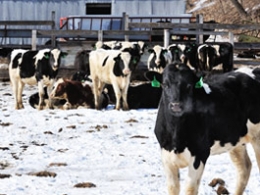
With falling temperatures and the increased chance of rain, hail, sleet and snow, winter brings many challenges to farmers and their livestock.
Up and down the UK farmers are responsible for:
- Over 9.9 million cattle & calves
- Over 33.3 million sheep & lambs
- Over 4.7 million pigs
- Over 168million birds*
…………….. that’s a lot of farm animals that need looking after through the cold winter months!
Whilst insurance can protect against loss of livestock and damage to farm buildings and machinery, you can take the first step in ensuring you’re ready for winter.
Preparation is key.
The Department of Defence (DoD) recently launched a new campaign “Be Winter ready” which puts a large emphasis on the need to plan. Some things covered in this campaign are what we see on a regular basis. For example in the past 5 years nearly 5% of our claims were related to burst pipes.
You should review all aspects of your farm to ensure you’re prepared for what the winter season brings. To help we’ve taken information from the DoD and created this handy checklist.
| Factors to consider | Why? | Checklist |
|---|---|---|
| Water supply |
Animals need a constant supply of water- they can’t go more than 24 hours without water. * Cold temperatures can freeze pipes which limits supply and can lead to pipes breaking, flooding buildings and making an uncomfortable housing environment. |
Exposed pipes should be identified and insulated to reduce the risk of freezing. |
| Feed |
The nutritional requirements of animals increases in cold weather. Energy can be provided through grains or roughage such as hay or silage. If stocks (predominantly sheep) are being kept outside, make sure additional feed is provided as grazing can be limited. |
Make sure you have enough feed (hay, silage, nutritional grain) for the winter months. |
| Buildings | Housing of stock needs to be structurally sound before any stock is brought inside. Holes in roofs cause leaks leading to damp bedding resulting in a higher chance of animals catching a disease. |
Check the infrastructure of a building
Check the roof is fully water proof with no leaks.
Check all water sources are working correctly
Check lighting |
| Machinery |
General maintenance should be undertaken on a regular basis to make sure your vehicle is in full working order. With icy road surfaces or wet fields, vehicles need to have appropriate tyres to limit the risk of skidding or getting stuck in the mud. |
Check oil and water levels. Check engine coolant & coolant fan. Apply winter tyres and or ensure vehicle tyres have appropriate tread. |
| Access |
Farm workers, suppliers such a feed companies or milk tankers need clear access in and out of the farm. With winter weather conditions access needs to be clear to prevent any incidents for taking place. |
Keep all farm entrances and farm yards clear to allow access.
If possible store and apply road salt to surfaces around the farm to limit the risk of a collision or injury.
|
There are also other factors to consider including farm safety and the risk of disease.
Working with stock is always a risk. In 2015 the Health and Safety Executive reported 23 cases where people were injured by an animal**. Employers need to remind workers about best practise when working with animals in order to limit the risk. This is particularly relevant at this time of year when stock is housed inside. As an employer you are liable so it’s important to make sure employees have the necessary knowledge to prevent an incident from happening.
When stock is housed inside for winter, a drop in temperature combined with poor ventilation can make pneumonia more likely, especially in young caFactlves. You should look out for symptoms such as nasal discharge, coughing, raised breathing as well as stock standing alone in a pen. Once identified it is easily treatable with antibiotics however with improved husbandry, ventilation and care it can be prevented***.
Although pneumonia is very common during winter months this year we have experienced different weather conditions to the norm. Recent news based on preliminary data suggests 2016 is going to be the warmest year on record globally****. This brings new challenges. For example the National Animal Disease Information Service has recently announced an increase in the likelihood of parasite disease in sheep due to the prolonged wet and mild summer, along with the threat of liver fluke in both sheep and cattle*****. You need to be aware of these diseases in order to provide treatment and limit the risk of losing stock. The best cause of action for liver fluke is dosing which will ensure the fluke are killed before they lay eggs******.
We all know that insurance provides certainty however stock is not easily replaced so preparation and prevention are key, especially in such an unpredictable climate. Changes in the season means there’s lots to think about when it comes to keeping livestock fit and healthy- some factors are common year after year but new things can crop up. By taking simple measures and being prepared you can mitigate the risks and maintain the day to day running of the farm.
Sources:
*https://www.gov.uk/government/uploads/system/uploads/attachment_data/file/557993/AUK-2015-05oct16.pdf
**http://www.hse.gov.uk/statistics/industry/agriculture/agriculture.pdf?pdf=agriculture
*** http://www.thecattlesite.com/diseaseinfo/176/calf-pneumonia/
**** http://www.farmbusiness.co.uk/livestock/sheep/significant-parasite-challenge-to-sheep-and-cattle-this-autumn-say-nadis-and-merial.html
*****http://www.bbc.co.uk/news/science-environment-37949877
******http://www.farmanimalhealth.co.uk/cattle-liver-fluke
